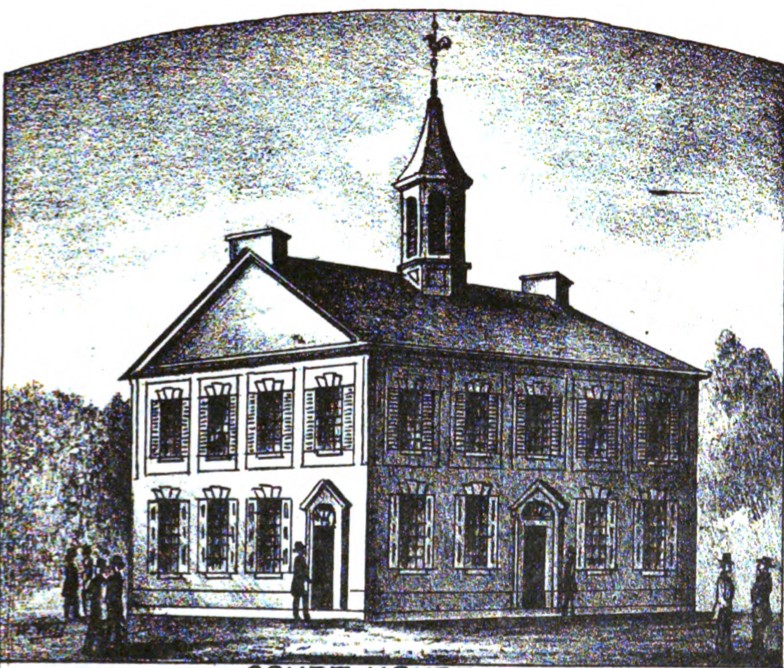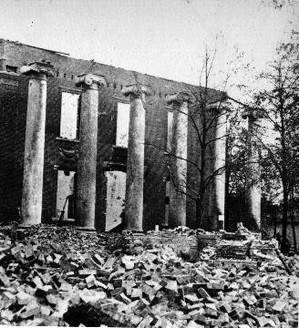Franklin County Courthouse
Introduction
Text-to-speech Audio
Images
Illustration of first Franklin County Courthouse, in use from 1794 to 1842, from the frontispiece of McCauley's "Historical Sketch of Franklin County, Pennsylvania."

Photograph of courthouse after its destruction by Confederate raiders. The Greek Revival columns were preserved as part of the new courthouse built in 1865. Courtesy of Wikipedia.

Backstory and Context
Text-to-speech Audio
The first Franklin County Courthouse to be built on the eastern side of Memorial Square (originally called the Diamond) was constructed by Captain Benjamin Chambers, son of Chambersburg founder Colonel Benjamin Chambers (who deeded the land for the courthouse to the county in 1774 for $26.66 2/3). Construction was completed on a fifty-foot-square, two-story brick building in 1794, which remained in use until the erection of a new courthouse in 1842 built in the Greek Revival style with a colonnaded front and oversized cupola.
Confederate raiders under Brigadier General John A. McCausland destroyed the second Franklin County Courthouse on July 30, 1864, as part of the burning of Chambersburg. The residents of Chambersburg completed construction on the third and current iteration of the Franklin County Courthouse in 1865, incorporating portions of the former courthouse that had remained standing after McCausland’s attack the previous year. A 1902 addition expanded the rear of the building and is faced with brownstone rather than the white stone of the original structure. On top of the building stands a metal statue of Benjamin Franklin, for whom the county is named, which replaced a wooden statue of Franklin that stood there from 1865 to 1991 and now resides in the Chambersburg Heritage Center on the opposite side of Memorial Square.
The Franklin County Courthouse that stands in Chambersburg today is a result of the efforts of the city’s residents to rebuild in the aftermath of Confederate General Jubal Early’s decision to destroy a northern community in retaliation for Federal attacks on towns in Virginia. There has been speculation since the time of the attack itself, thus far unproven, that Early chose Chambersburg for its association with the abolitionist John Brown, who boarded in Chambersburg while making preparations for his famous raid on Harpers Ferry in 1859. (Early himself stated afterward that he chose Chambersburg simply because it was convenient to his location at the time.) Regardless, Early ordered his subordinate Brigadier General John A. McCausland to hold the town for ransom, demanding either $100,000 in gold or $500,000 in “greenbacks.”[1] If the town could not or would not pay, Early had authorized McCausland to destroy it.
McCausland arrived at the outskirts of town from Martinsburg, West Virginia on July 30, 1864 with 3,000 Confederate cavalry and two artillery batteries. After establishing his batteries on a hill overlooking the town from the west, McCausland opened with a brief bombardment before advancing into the Diamond with 500 cavalrymen under Major Harry Gilmore. Upon reaching the Diamond, he had his men ring the courthouse bell to call Chambersburg’s residents to him. Those that arrived chose to refuse the demands McCausland issued to them, after which he ordered the destruction of the town. The courthouse was among the first buildings destroyed, but it was by no means alone. McCausland’s men progressed through the town by quarters, systematically setting fire to businesses, residences, and outbuildings without any warning to potential occupants. The attack left thousands of Chambersburg residents without homes and caused an estimated $1.6 million in damage. Their plight prompted a nationwide aid campaign, which helped fund early reconstruction efforts (including the rebuilding of the courthouse on the remains of the old one). The new courthouse, opened in October of 1865, enlarged upon the dimensions of the former in order for the cupola’s proportions to match the rest of the building and featured a newly installed wooden statue of Benjamin Franklin on top of the cupola to commemorate the county’s namesake.
The Franklin County Courthouse doesn’t just offer a glimpse into the experiences of a northern community uniquely impacted by the American Civil War and its hardships. It is also a window into a transitional period in American architecture. With the exception of an addition to the structure’s rear in 1902 and the upgrading of the building’s interior to include modern amenities in the twentieth century, the Franklin County Courthouse has remained largely intact since its construction in 1865. Moreover, those responsible for the building’s construction, upgrades, and maintenance have made efforts to preserve the integrity of the second courthouse’s original Greek Revival architecture as well as its successors core design features. The courthouse’s colonnaded front remains standing from the courthouse burned by Confederates in 1864, evidencing the structure’s original Greek Revivalist character, while the rest of the building evinces a more Victorian flavor in the elaborately carved stone molding around its fifty-four windows.
The Franklin County Courthouse’s role in the course of events during the 1864 burning of Chambersburg and its nature as a sort of architectural time capsule preserving the transition from the Greek Revival to Victorian periods lends it unique historical and architectural significance. It stands at the heart of Chambersburg’s historic downtown district, which mirrors the building’s unique character on a larger scale. Much, but not all, of the area was destroyed in the 1864 fire and rebuilt alongside the new courthouse. As the residents of Chambersburg worked to rebuild their lives in the wake of the Confederate attack (and the war in general after 1865), the courthouse served as it had before as the heart of daily life, law, and governance. Its history can help to deepen our appreciation of the strategic importance of the area between Pennsylvania, Maryland, Virginia, and later West Virginia to both armies during the Civil War. It can also, however, broaden our understanding of the impact of that conflict on civilian populations, especially ones that were forced to rebuild after periods of occupation.
[1] "The Burning of Chambersburg," Pennsylvania Civil War Trails, , accessed April 18, 2019, https://www.pacivilwartrails.com/stories/tales/the-burning-of-chambersburg.
